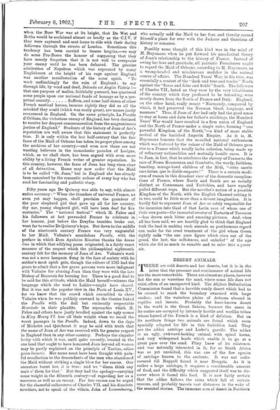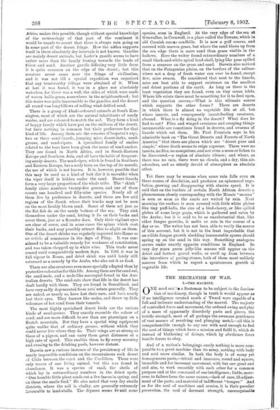DESERT ANIMALS.
THERE are cold deserts and hot deserts, but it is in the latter that the presence and continuance of animal life are the more remarkable. There are almost no places, however hot the sun or waterless the sand, where some life does not exist, often of an unexpected kind. The Afghan Delimitation Commission found that a horrible sandy desert which had to be crossed to reach the boundary swarmed with large snakes ; and the waterless plains of Arizona abound in reptiles and insects. Probably the least-known desert in the world is the Great Sahara, because the oases in its centre are occupied by intensely hostile and warlike tribes whose hatred of the French is a kind of delirium. But on its northern fringe two animals are found which seem specially adapted for life in this forbidden land. They are the addax antelope and Loder's gazelle. The addax is an ugly, awkward-looking animal, with spiral horns, and very widespread hoofs which enable it to go at a great pace over the sand. Pliny, . knew of its existence, and was naturally interested in it, for as South Africa was as yet unvisited, this was one of the few species of antelope known to the ancients. It was not redis- covered till Ruppell found it near Dongola. As it is rather a large antelope, it requires a considerable amount of food, and the difficulty which suggested itself was to dis- cover where it found this food. It is now fairly certain that the addax follows the rains which fall at certain seasons, and probably travels vast distances in the wake of the seasonal storms. The immense area of desert in Northern
Africa makes this possible, though without special knowledge of the meteorology of that part of the continent it would be unsafe to assert that there is always rain going on in some part of the desert fringe. How the addax supports itself in these absolutely dry intervals is not known. Gazelles are mainly desert animals, but Loder's gazelle seems to have rather more than the family leaning towards the lands of thirst and sand. Another gazelle differing very little from it is quite common on the edge of the desert; but this creature never came near the fringe of civilisation, and it was not till a special expedition was organised that any trustworthy tidings were obtained of it. When at last it was found, it was in a place not absolutely waterless, for there was a well, the sides of which were made of woven halfa-grass, somewhere in the neighbourhood ; but this water was quite inaccessible to the gazelles, and the desert all round was long billows of rolling wind-drifted sand.
There is a group of khaki-coloured animals at South Ken- sington, most of which are the natural inhabitants of sandy wastes, and are coloured to match the soil. They form a kind of happy family which have put on the uniform of the desert, but have nothing in common but their preference for that kind of life. Among them are the cerastes (Cleopatra's asp), two or three sand-lizards, jumping mice, desert-larks, sand- grouse, and sand-vipers. A specialised family of snakes related to the boas have been given the name of sandenakea. They are found in North Africa, and in South-Eastern Europe and Southern Asia, and all have the habit of frequent- ing sandy deserts. The sand-viper, which is found in Southern and Eastern Europe, has a scaly horn on the top of its muzzle, the use of which is not known. It is, however, possible that this may be used as a kind of bait (for it is movable) when the viper itself is hidden under the sand. Desert-lizards form a very large proportion of the whole tribe. The " skink " family alone numbers twenty-five genera, and one of them counts one hundred and fifty-nine species. Nearly all of them live by preference in deserts, and there are few arid regions of the South where their tracks may not be seen on the most freshly blown sand. Some of them act just as the fiat fish do on the sandy bottom of the sea. They sink themselves under the sand, letting it lie on their backs and cover them, just as a flounder does. Only their vigilant eyes are clear of cover, and in some cases the spines which coat their backs, and may possibly attract flies to alight on them. One of the desert skinks was regularly imported into Rome as an article of commerce in the days of Pliny. It was con- sidered to be a valuable remedy for weakness of constitution, and was taken chopped up in white wine. This trade never ceased until comparatively modern days. In 1581 it was in full vigour in Rome, and dried skink was until lately still esteemed as a remedy by the Arabs, who also eat it as food.
There are also creatures even more specially adapted than by protective coloration for this life. Among them are the sand-rat, the sand-mole, and a mole-like marsupial found in the Aus- tralian deserts. The sand-rats show that life in the desert has dealt hardly with them. They are found in Somaliland, and have very sadly degenerated from rats' estate generally. They are naked, or nearly so, have lost their ears, and have nearly lost their eyes. They burrow like moles, and throw up little volcanoes of hot sand from their tunnels.
The most highly specialised desert birds are the various kinds of sand-grouse. They exactly resemble the colour of sand, and are more difficult to see than are ptarmigan on a Scotch mountain. But they have a special wing equipment quite Unlike that of ordinary grouse, without which they could never live where they do. Their wings are as strong as those of a pigeon, and can carry them great distances at a high rate of speed. This enables them to fly every morning and evening to the drinking pools, however distant.
Darwin saw a curious instance of the persistency of life in nearly impossible conditions on the mountainous rock desert of Chile between the coast and the Cordillera. There were only traces of one living animal, but this was found in abundance. It was a species of snail, the shells of which lay in extraordinary numbers in the driest spots. .‘ One humble little plant sends out a few leaves in spring, and on these the snails feed." He also noted that very dry sterile districts, where the soil is chalky, are generally'-extremely favourable to land-shells. The. dryness seems tea-snit some species, even' in England. At the very edge of the sea at Gunwalloe, in Cornwall, is a place called the Towans, which in old Cornish means sandhills. It is now a golf course; and covered with uneven grass, but where the sand blows up from the sea edge there is more sand than grass visible in the hollows. Here the writer found extraordinary numbers of a small black-and-white spiral land-shell, lying like peas spilled from a measure on the grass and sand. Darwin also noticed that on the Patagonian plains, on the borders of the salsas, where not a drop of fresh water can ever be found, except dew, mice swarm. He considered that next to the lizards, mice are best able to support existence on the smallest and driest portions of the earth. As long as there is the least vegetation they are found, even on tiny ocean islets. Where life exists there must be something for it to feed upon, and the question occurs,—What is this ultimate source which supports the other forms ? There are deserts in which there is almost no vegetable life at all, but where insects, and consequently insect-feeding creatures, abound. • What is a fly doing in the desert ? What does he• find to eat ? Flies and winged creatures and creeping things innumerable are sometimes found in deserts, and swarms of lizards which eat them. Mr. Paul Fountain says in his admirable book on "The Great Deserts and Forests of North America" that there are places which are "desert pure and . simple," where death seems to reign supreme. There were no insects, no flies, no mosquitoes, and not even a moss or lichen to be discovered,—a region of absolute silence; and where, as there was no rain, there were no clouds, and a dry, thin air, odourless, and as utterly devoid of atmosphere as absolute ether.
Yet there may be seasons when some rain falls even on•these scenes of desolation, and produces an ephemeral vege-
tation, growing and disappearing with elusive speed. It is said that on the borders of certain North African deserts a phenomenon closely corresponding with the Mosaic "manna" is seen as soon as the sands are wetted by rain. Next morning the surface is seen covered with little white globes like tiny puff-balls, the size of a bird-cherry, or like spilled globes of some large grain, which is gathered and eaten by the Arabs ; but it is said to be so unsubstantial that, like other fungus growths, it melts or rots in the course of a day or so. The writer has not been able to verify the source of this account, but it is not in the least improbable that an edible fungus growth shedding innumerable spores should spring up on the sand in this way. Something analogous occurs under exactly opposite conditions in England. In very dry years green jelly-like masses will appear on the driest and hottest gravel walks, or swell up from between the interstices of paving-stones, both of them most unlikely sources from which to expect a spontaneous growth of vegetable life.











































 Previous page
Previous page